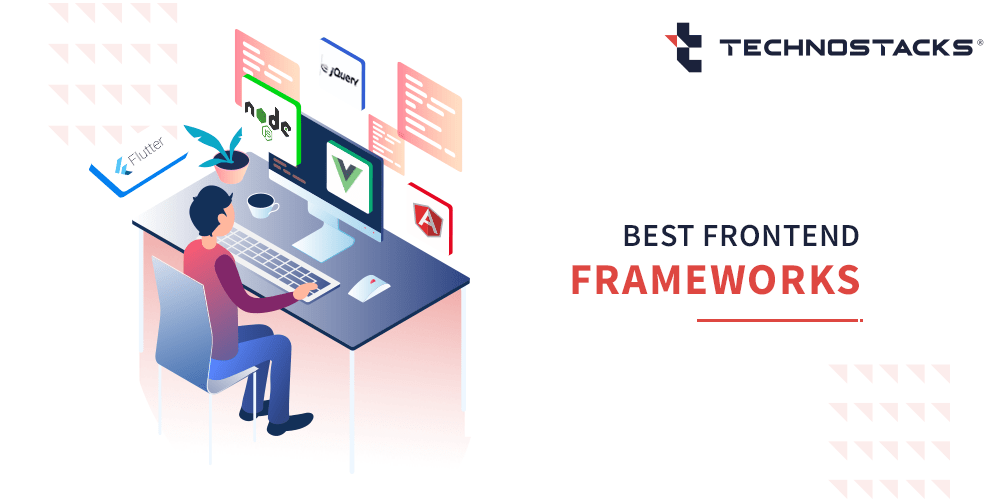Top Frontend Frameworks for Web Development
Developing what the users see on their screens is the role of a front-end web developer. Unarguably, front-end developers worldwide are trying to use the best front-end frameworks to provide the best user experience.
The digital market has become a competitive space since many businesses are joining the league each year. There was a time when only a few players developed their digital platforms and started offering their products and services. With the technology boom, organizations understood that online interaction and presence is the future.
Today, the end-user is the focus, and it is crucial to render a great experience to retain customers in the long run. The first step in this process is developing a user interface that is seamless and appealing. Indeed it means developers dealing with complex operations and functions. But ultimately, the efforts result in profitable business growth.
Tech giants have been extensively using frontend frameworks. As the name suggests, frontend refers to how an application or website looks to the user. The content arrangement, typography, graphics, etc., all contribute to the visual appeal of the platform. Thus, the frontend framework can be defined as the tools used to build the visual aspect website or application. Some of the major tasks associated with this framework are:
- Managing AJAX requests
- Correlating data with the document object model
- Outlining file structures
- Styling and designing of app or website components
hurdles
What are Frontend Frameworks?
Before discussing the top Front-end Frameworks, let’s understand what Front-end frameworks are. To understand a Front end framework, we need to know what the front-end is. The front-end of a website or application is the stuff visible to the user on the website. The graphics, typography, and arrangement of these two are what contribute. In addition, it includes building user-friendly interfaces and efficiently presenting the data from the back end to a user.
Thus, a Front-end Framework is a platform/tool to build the front end of your website. Some of the tasks one can perform using a Front-end Framework are – the management of AJAX requests, associating data with The Document object Model (DOM) elements, defining a file structure, and styling of components on the website or application.
Best front-end Frameworks in 2025
When it comes to Frontend Frameworks for web development, there will always be debates regarding which among them is the best. However, after researching the recent studies and surveys about the most popular Front-end frameworks, we have come up with an explicit list of the best front-end frameworks for you. This list is prepared as per the surveys conducted by Github stars.
With immense development in technology, there are several frameworks available that developers can work with. Each framework offers a unique feature, and thus, it becomes crucial for the developer to choose the right one. Since every business has a different goal, the web or app should be developed in correspondence to the same.
The ranking of these Frontend Frameworks for web development decides as per the following three crucial factors –
Type of applications you can create with it
One of the most important deciding factors in choosing a front-end framework is what type of application or website you want to create. Whether it is a large-scale application or a small-scale web application, the choice of a framework varies a lot. The most popular front-end frameworks for large-scale applications are – vue.js, react.js, angular, and smaller web applications – jquery and Backbone Js.
The ease of learning and using
With the growing popularity of the digital world, more and more new developers are emerging each passing day. Today, people believe in learning skills that are easy to learn and can help them earn a good living. Therefore, newly emerging front-end developers prefer learning the frameworks that are easy to learn and use and have all the features needed. For example – Reactjs, Vuejs, and Backbonejs are some of the simplest and easiest frameworks to learn than the complex frameworks like angular.
Developers Income
If we think from a developer’s point of view, we’ll prefer the framework that earns us the most. That’s right! Developers working on different frameworks have different earnings. For example, a detailed discussion on front-end frameworks and a Q&A on the website Stack Overflow revealed that front-end developers working on Reactjs and Nodejs frameworks earn $95,000 – $105,000 on average. Therefore most developers prefer learning and opting for React.js to develop the Front-end of a website.
Factors Considered when Shortlisting the Most Used Front End Framework
Shortlisting the best frameworks is a tough job since each one of the available frameworks has a USP. Thus, this List is based on three broad factors to make it easier for the developers.
- Type of web or app that the developer wants:
One would need a framework depending on the kind of app or web he intends to develop. A large-scale vs a small-scale app will need different features, and hence, one needs to choose the framework accordingly.
- Simple and easy to adapt frameworks:
Developers need to work with several projects simultaneously, and hence, they need simple frameworks. Thus, new developers prefer such frameworks over the complex ones to stay ahead of the competition and render better output to their clients. Easy adaptability allows quick learning and better results.
- Cost-effectiveness:
Developers prefer working with the latest frontend frameworks that offer the best features and are cost-effective. It helps them earn more and thus, are popular.
Now that we know what Front-end Frameworks actually are and what they are used to discuss the best front-end frameworks in 2025. So, if you a front-end developer or simply looking to hire a dedicated front-end developer, you’ll know what framework is your go-to option.
1. React
Considering how easy it is to learn and how much money a ReactJs Front-end developer makes, ReactJs could easily steal the number one spot for the best Front-end Framework. Now an open-source framework, React was originally developed by Facebook’s team.Facebook was an emerging app and needed constant additions and improvements, making it hard to fix and maintain the coding part. React allowed them to make changes to the code easily. The unique thing about react is the Virtual Document Object Model (DOM) with exceptional functionality.
Advantages
- React is easy to learn and use.
- React allows you to reuse an already built component in your code. This way, it’s easier to collaborate and use these components in other parts of the application.
- Use of its virtual DOM allows a seamless performance and ensures that even high-load applications have fast rendering.
- Increased productivity and maintenance. New changes in the application can be easily made.
- It has a browser extension named React Developer Tools, which allows them to make detailed observations of their components and make them better.
Limitations
- In the initial phases of learning React, it can be difficult for the developers to understand the concepts of JSX.
- ReactJS is used for developing only the UI part of the application. Therefore, to get complete development tools, you will have to rely on other technologies.
- As the components can be easily updated at high speed, it isn’t easy to maintain proper documentation.
Applications
React is mostly used for developing single-page applications. However, it is a framework specifically used for User Interface development. It comes in quite handy when you require building an interactive interface for an application within a limited time because you can reuse the components in this framework.
Where can you not use React?
JSX is pretty tough when it comes to learning. Therefore, if you are a new developer, it’s recommended not to use React. Secondly, the knowledge of JavaScript is necessary for using React. In case you don’t know JavaScript, React is not the go-to option for you.
2. Angular
The only of the many Front-end Frameworks in 2025 based on TypeScript, Angular makes its spot on this list. Angular was initially released in the year 2010 by Google as AngularJs. The now known version of the Framework (Angular 2+) was developed and deployed in 2016, keeping in mind the need for improved technology to overcome the hurdles faced by the conventional Frameworks. Similar to ReactJs, it is an open-source platform used to develop user interfaces on the front end. Also read:- React vs Angular: Which Is A Better JavaScript Framework?
The one main difference between React and Angular is that Angular has a two-way binding feature. The presence of this feature allows the integration of any changes made in the model with the view. This way, a developer would see what changes they are making in the application and how it looks in real-time.
Angular usually deals with the development of mobile and web applications. Not just that, but one can easily build both single and multi-page web applications. Due to its various features, Angular is opted by some of the biggest companies in the world, including Microsoft Office, BMW, Forbes, Gmail, and Upwork.
Although Angular has better features when compared to React, it is not easy to learn. The framework is a bit complex and thus takes time to excel at.
Read more: Features & Differences Of Angular 9 and Angular 8
Advantages
- The in-built functionality of this framework allows real-time model-view synchronization and makes it easier to make any changes to the application.
- The presence of Directives allows the developers to play around with the Document Object Model (DOM) and create rich content using HTML.
- Dependency injectors allow the developers to decouple interdependent components of code and reuse these components however they need.
- Angular gained popularity among the developers since it was launched. Today, there’s a big community of web developers who use Angular. A developer can easily seek help from this community if he faces an issue.
Limitations
- The wide variety of features and built-in functionalities make Angular a very complex language to learn.
- Dynamic applications can lag sometimes and may not perform up to the mark.
Applications
Angular is the go-to option for most enterprise-based and dynamic web applications due to its two-way data binding that allows browser-based applications to augment.
When can you not use Angular?
Angular is the complete dynamic solution as a Framework. Thus, if you want to build small-scale web applications, you may not want to opt for Angular because you would not utilize its resources to the best. It would merely be a misuse of time and resources. Furthermore, if you are a new developer with a small team, you should avoid using the complex Frameworks like Angular.
3. VueJs
The developers of VueJs have combined the existing Front-end Frameworks’ best features to deploy a simple and straightforward framework. Firstly, it is not complex like Angular, which makes it easy to learn and use. Secondly, it is much smaller in size and similar to Angular, offers two-way binding, Visual DOM, and component-based programming.
VueJs is a framework that allows you to build both dynamic and small web applications with ease. However, despite being versatile, it is not yet popular among big-scale companies. This is because most large-scale companies still trust Angular for enterprise-based web applications. Some of the companies that use VueJs are Alibaba, 9gag, and Xiaomi.
Also read:- Best JavaScript Frameworks Recommended By JS Communities
Advantages
- Availability of detailed documentation for learners.
- Supports the development of both complex dynamic applications and simpler smaller applications.
- The syntax of this framework is very simple and thus easier to work with.
- Presence of a virtual DOM.
Limitations
- Vue, being in high demand in China, has many of its documentation built-in Chinese, which creates a language barrier for people accessing these documents outside of China.
- VueJs is still in its growing stages and thus does not have a large community.
- VueJs provides a wide range of features, but it’s not as big as React or Angular.
Applications
VueJs is suggested to be used for projects that need greater flexibility. You can design everything from scratch and therefore allows designing dynamic applications with more ease.
When not to use
Despite having a wide range of features, VueJs is still not successful in creating stable components. Another reason why you wouldn’t want to opt for VueJs is if you’re looking for a community where you can seek help if you face any hurdles.
4. JQuery
Since its development in 2006, JQuery has been around for quite some time now. Despite being an older Framework, it is still popular and widely used. JQuery is a very simple Framework that is easy to learn. With the framework, one doesn’t need to write extensive JavaScript code. The good thing is it is still used and is developing into a better version of itself each day. With the development of JQuery Mobile, one can easily develop mobile applications, which was not possible initially.
Advantages
- JQuery is one of the simplest Frameworks out there. Even with very little programming language knowledge, one can easily use JQuery. This is the reason why it is still considered one of the best front-end frameworks in 2025.
- Despite being a simple framework, it can still be used to deploy dynamic applications.
- Components can be easily added or removed due to its flexible DOM.
- An open-source platform that simplifies HTTP requests.
Limitations
- JQuery is an older platform, and many new and better frameworks are available in the market today.
- JQuery allows the development of dynamic applications but at a slower rate.
- The lightweight interface of JQuery may lead to problems in the longer run.
Applications
If you want to develop desktop-based JavaScript applications, JQuery is a go-to option.
When not to use
JQuery is not suggested for building large-scale applications because the excess JavaScript code might make your application heavy.
5. EmberJs
With its component-based functionality and two-way data binding, Ember resembles Angular a lot. It was developed in 2011 owing to the demands of modern technologies. Despite being one of the toughest frameworks to learn, it is still used by some of the largest companies like LinkedIn and Apple. This is because it allows developers to develop complex mobile and web applications easily.
Advantages
- It is one of the fastest frameworks available in the market.
- It provides two-way data binding.
- A well-developed and fully packed package ecosystem for all your needs.
- It is backward compatible, so older versions of applications will still work flawlessly despite new updates.
Limitations
- The learning curve of EmberJs is very steep.
- It has a very complex syntax, and therefore working on it can be frustrating sometimes.
- Building small applications on Ember might feel like a waste of a heavy framework.
Applications
Modern applications focused on deploying a rich user interface use EmberJs. Companies like LinkedIn and Apple use it.
When not to use
EmberJs is not a preferable framework for developing smaller applications because a lot of its resources won’t even be utilized. If you have a small team of developers, try to avoid using Ember because its initial cost is high, and it may not be the right choice for creating a simple user interface.
6. Backbone.JS
An open-source, free-to-use framework, this was developed in 2010 by Jeremy Ashkenas. It is a popular, most used frontend framework for creating small, single-page web apps. It keeps the app logic and UI separated, making it easy for developers. It can also be used for bigger projects that demand better design with less coding.
Advantages
- This framework translates the developer’s data into models which are easy to create, validate, and eliminate. Therefore, every time there is a change in UI action, it alters an element of the model, enabling custom events and key-value binding.
- Developers do not need to write different codes for ID-specific elements.
- The platform has enumerable API-rich functions that help design an effective app or web page.
- One of the quick responding JavaScript frameworks.
- A range of extensions are available.
- Small-size file that can be easily zipped.
- Less number of requests to HTTP.
- Data is stored as models.
- Easy to learn and implement for new developers.
- Elaborate tutorials are available, enabling the best use of features.
Limitations
- It does not offer two-way binding for data.
- Indistinct architecture.
- Developers may need to write more codes.
- Needs up-gradation with evolving technology and needs.
Applications
Ideal for developing applications that demand dynamic handling of updates, continuous server and application synchronization, etc. The codes can be updated and reused easily.
When not to use?
This framework is not recommended in cases where the developer needs a whole package of features in one. One needs to download extensions and plugins to extend the features of this minimalist framework. Thus, this indeed is not a one-stop framework.
7. Svelte
One of the most trending frameworks for frontend development, Svelte offers an easy-to-use platform. It is a compiler that was introduced in 2016. It puts all the codes as one compiled step rather than posting in the browser. This helps update the Document Object Model with ease and in sync with the application’s current state.
Advantages
- Uses current JavaScript libraries to render a simple framework.
- SEO-optimized frontend framework.
- Lightweight and responsive.
- Minimal coding with feature-focused architecture.
- Scalable.
Limitations
- Lack of technical support and tutorials.
- Small, limited ecosystem.
- Limited tooling and less popular amongst developers.
Applications
Svelte is apt for small projects that limited people handle. The framework is ideal for beginners due to its simple syntax and less load on the browser. This helps in speeding up the web or app product.
When not to use?
Developers dealing with complex projects should avoid using Svelte. The framework offers limited tooling and a small community, making it challenging to deal with bugs and challenges that come in a later stage of development.
8. Semantic UI
Semantic UI is comparatively new in the industry. It has been accepted as one of the leading frontend frameworks for web development. The usability, simplicity, and spontaneous user interface are behind its success. It uses a simple coding language, and hence, freshers find it easy to grasp and work with. There is a streamlined process for web and app development, and it has collaboration with several third-party libraries that make it a fantastic development platform.
Advantages
- Simple, organic codes.
- Responsive and UI-rich components.
- A toolset that allows configuration of themes, CSS, and JavaScript.
- Code created once can be easily shared with several other applications.
Limitations
- Small community.
- Developers need to know JavaScript.
- Demands proficiency in designing custom configurations.
Applications
Semantic UI is a fantastic platform for developers and designers who desire lightweight, responsive, and seamless user interfaces.
When not to use?
This frontend framework is not recommended for a team with less experienced developers. The customizations require knowledge of coding with less dependence on ready-to-use functions.
9. Foundation
This platform is for experienced developers, but it is impressive and fruitful to work with once someone is well-acquainted with this framework. Zurb developed this framework to cater to enterprise-level web and app development. It has advanced features and offers excellent GPU acceleration that facilitates some of the best features. Foundation comes with quick, responsive features, lightweight sections for mobile apps, heavy sections for other devices, smooth animations and transitions. It is the perfect amalgamation of components that any developer would desire. The leading tech giants have been successfully using this frontend framework.
Advantages
- Features enabling exclusive and appealing websites.
- Offers flexibility in using grids.
- Developers can design customized end-user experiences depending on the device used.
- HTML5 library validation.
Limitations
- Challenging framework for beginners.
- Limited support and community forums due to complex design.
- Tough competition from other popular framework competitors.
Applications
Foundation stands as a winner if one has the knowledge and experience to work with it. It offers CSS features and an appropriate framework for mobile app development.
When not to use?
Beginners should avoid using this framework as the codes involved are complex and may create challenges in the development process.
10. Preact
Preact renders the thinnest and fastest virtual DOM library. It has been designed to be used without any transpiling. This means it can be directly used in the browser and interact well with other libraries. It is based on JavaScript and was introduced by Jason Miller. The aim was to keep the framework size small and still offer the best features to developers.
Advantages
- The quick and responsive frontend framework.
- Lightweight, 3kb size.
- Easy to learn and execute codebase.
- Designed to maximize memory usage.
- Well-designed command-line tool.
Limitations
- Small community due to limited popularity amongst developers.
- It does not support propTypes, the salient feature of React.
- Works with ES6 components only.
- No support for refs yet.
- Works with browser API and hence no support for developers desiring synthetic event execution.
Applications
This framework is ideal for developers concerned about size, speed, and performance. It is perfect for designing advanced web applications with simple landing pages and small widgets. If the app or web targets users with slow internet or want a short loading duration, Preact is the right choice.
When not to use?
Several organizations still use React as their frontend framework, and thus, if they plan to switch to Preact, they might lose some of the present React features. This can be a concern. Preact should be avoided for complicated and heavy web apps as it would mean installing additional packages.
Key Takeaways
The choice of frontend framework essentially varies according to the business goal, target audience and desired website or application design. Thus, developers should keep a close check on the developments in this segment. Choosing the proper framework would mean making the first correct move toward future goals.
So far, we’ve discussed some of the best front-end frameworks available. However, the technology is ever-evolving, and who knows, we may have an even better Framework shortly.
Besides developing new Frameworks, the already available ones are spreading their roots deeper in the market through regular updates and introducing better features. Therefore, there will always be various Frameworks available for the Front-end developers to learn and work with.
Technostacks has a dedicated team of front end developers. Contact us for front end development projects or hire our professional front end developers.
FAQs of Front-end Frameworks
1. What are front-end frameworks?
They are CSS frameworks and packages having pre-written, standardized code in folders and files. They offer you a base to develop on while still enabling flexibility with the concluding design.
2. Which front-end framework can be used for large-scale applications?
Currently, there are 3 significant front-end technology stacks – Vue.js, React.js, and the Angular ecosystem, which are extensively used for large-scale projects.
3. Which front-end framework can be used for small web applications?
We would recommend JavaScript and jQuery for small web application projects.
4. Which front-end frameworks are easier?
React is easy to collaborate and learn. Vue can manage processes effortlessly, and Backbone.js is quite easy to learn.
5. Which front-end frameworks are difficult to learn?
When matched to React, Angular is difficult to learn.
6. When should I use the front-end framework?
A front-end framework offers you an assurance that you are building an application that is compliant and well-structured, and that is further upgradable and maintainable.
7. Is Django a front-end framework?
Neither. Django is a framework or a language. It is a collection of Python libraries enabling you to swiftly build a superior-quality web-based application, and it is fit for both front-end and back-end development.
8. Is jQuery a front-end framework?
jQuery is a cross-platform JavaScript library built to ease the client-side scripting of HTML.
9. Which popular front-end framework is utilized the most?
React.js is the most used and popular framework globally. It is simple to learn, can be leveraged in any project category, and has a massive community.
10. Which is the fastest front-end framework?
Svelte is a lightweight front-end framework used to enable projects with minimal coding and is the swiftest framework in the marketplace.
11. Is Node.js just a front-end framework?
There is a misunderstanding among professionals that Node.js is a back-end framework and is only leveraged for enabling servers. This is not true: Node.js can be utilized both on the front end and the back end.








